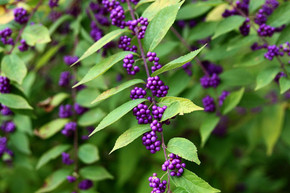

We are unable to ship to any US Territories, AK, AZ, CA, CO, HI, ID, MT, NM, NV, OR, UT, WA, or WY
The biggest of North American Carrot family member!
Majestic looking native biennial or short-lived perennial, with huge leaves and 6-8" wide umbels of tiny white flowers.
Pollinator magnet for various insects. Seedheds stay ornamental to the winter. Reseeds where happy.
Can irritate or blister skin to sensitive people (when touched and exposed to sunlight = use gloves).
Hollow stems were used by Native American to call and attract the deer, sweet young flowering stems and leaves were eaten.
Size : in ideal conditions on rich soil up to 8' tall x 3'+ wide, but usually shorter 4-5' tall
Blooming time : June-July
USDA zones : 4 to 10
Culture : sun, half sun, half shade, adaptable to average soil with average moisture, for full size is recommended loamy rich or richer soil, slightly moist to medium-moist
Moisture Needs : medium-moist,medium,
Origin : native to bigger portion of USA ad Canada (except the deep south), see the BONAP distribution map. Naturally occur in various habitats (high quality ones to disturbed) - from meadows in woodland openings, moist prairies, bottomland woodlands, floodplains, woodland edges, thickets, streambanks, partially shaded roadsides.
Deer/rabbit resistant : yes/yes
Attracts Hummingbirds : no
Attracts pollinators : offers easily accessible pollen and nectar, so it's very favorite to many pollinators - honeybees, various native bees (cuckoo bees, plasterer bees, masked bees, Andrenid bees, Halictid bees) and wasps (Sphecid wasps, Vespid wasps, spider wasps, Tiphiid wasps, Ichneumonid wasps). Dark-winged fungus gnats, many flies (soldier flies, Syrphid flies, dance flies, Tachinid flies, flesh flies, blow flies, Muscid flies, frit flies), long-horned beetles, tumbling flower beetles, flower chafers, plant bugs, and occasional butterflies too.
Some insects feed destructively on the foliage, fruit or sap - larvae of leaf-mining flies, larvae of Hogweed Picture-wing Fly, larvae of Parsnip Webworm Moth, Carrot Plant Bug, Cow Parsnip Thrips, and aphids (Aphis decepta, Cavariella, Willow-Carrot Aphid, Willow-Umbellifer Aphid, Willow-Parsnip Aphid). Some mammals, especially in the western part of USA feed on the flowers and foliage - elk, deer, cattle, horses, sheep.
Pot Size : square 3.5" x 4" deep perennial pot
Plant combinations : Best for naturalistic plantings, meadows, prairie style planting, woodland edge, cottage gardens. Good companions are plants that like or tolerate more moisture like Amsonia, Asclepias incarnata, Baptisia, Brunnera, Caltha palustris, Chelone, Eupatorium, hardy Geranium hybrids (with blue flowers), Helianthus angustifolius and hybrids, Hemerocallis, native herbaceous Hibiscus and hybrids, Iris (I. sibirica, I. x lousiana, I. versicolor, I. ensata, I. pseudata, I. virginica), Lobelia, Lysimachia, Mimulus, Packera aurea, Penstemon calycosus (and hybrids = with dark leaves and purplish flowers), Persicaria amplexicaulis, Phlox paniculata, Phlox maculata, Physostegia, Primula, Rudbeckia laciniata (better shorter cultivars), Sanquisorba, Spigelia marilandica, Thalictrum, Veronicastrum and grasses and sedges - Carex, Chasmantium, Deschmapsia, Hystrix, Hakonechloa, Panicum.
Picture copyright : Nichole Ouellette, Commons Wikipedia
The biggest of North American Carrot family member!
Majestic looking native biennial or short-lived perennial, with huge leaves and 6-8" wide umbels of tiny white flowers.
Pollinator magnet for various insects. Seedheds stay ornamental to the winter. Reseeds where happy.
Can irritate or blister skin to sensitive people (when touched and exposed to sunlight = use gloves).
Hollow stems were used by Native American to call and attract the deer, sweet young flowering stems and leaves were eaten.
Size : in ideal conditions on rich soil up to 8' tall x 3'+ wide, but usually shorter 4-5' tall
Blooming time : June-July
USDA zones : 4 to 10
Culture : sun, half sun, half shade, adaptable to average soil with average moisture, for full size is recommended loamy rich or richer soil, slightly moist to medium-moist
Moisture Needs : medium-moist,medium,
Origin : native to bigger portion of USA ad Canada (except the deep south), see the BONAP distribution map. Naturally occur in various habitats (high quality ones to disturbed) - from meadows in woodland openings, moist prairies, bottomland woodlands, floodplains, woodland edges, thickets, streambanks, partially shaded roadsides.
Deer/rabbit resistant : yes/yes
Attracts Hummingbirds : no
Attracts pollinators : offers easily accessible pollen and nectar, so it's very favorite to many pollinators - honeybees, various native bees (cuckoo bees, plasterer bees, masked bees, Andrenid bees, Halictid bees) and wasps (Sphecid wasps, Vespid wasps, spider wasps, Tiphiid wasps, Ichneumonid wasps). Dark-winged fungus gnats, many flies (soldier flies, Syrphid flies, dance flies, Tachinid flies, flesh flies, blow flies, Muscid flies, frit flies), long-horned beetles, tumbling flower beetles, flower chafers, plant bugs, and occasional butterflies too.
Some insects feed destructively on the foliage, fruit or sap - larvae of leaf-mining flies, larvae of Hogweed Picture-wing Fly, larvae of Parsnip Webworm Moth, Carrot Plant Bug, Cow Parsnip Thrips, and aphids (Aphis decepta, Cavariella, Willow-Carrot Aphid, Willow-Umbellifer Aphid, Willow-Parsnip Aphid). Some mammals, especially in the western part of USA feed on the flowers and foliage - elk, deer, cattle, horses, sheep.
Pot Size : square 3.5" x 4" deep perennial pot
Plant combinations : Best for naturalistic plantings, meadows, prairie style planting, woodland edge, cottage gardens. Good companions are plants that like or tolerate more moisture like Amsonia, Asclepias incarnata, Baptisia, Brunnera, Caltha palustris, Chelone, Eupatorium, hardy Geranium hybrids (with blue flowers), Helianthus angustifolius and hybrids, Hemerocallis, native herbaceous Hibiscus and hybrids, Iris (I. sibirica, I. x lousiana, I. versicolor, I. ensata, I. pseudata, I. virginica), Lobelia, Lysimachia, Mimulus, Packera aurea, Penstemon calycosus (and hybrids = with dark leaves and purplish flowers), Persicaria amplexicaulis, Phlox paniculata, Phlox maculata, Physostegia, Primula, Rudbeckia laciniata (better shorter cultivars), Sanquisorba, Spigelia marilandica, Thalictrum, Veronicastrum and grasses and sedges - Carex, Chasmantium, Deschmapsia, Hystrix, Hakonechloa, Panicum.
Picture copyright : Nichole Ouellette, Commons Wikipedia
